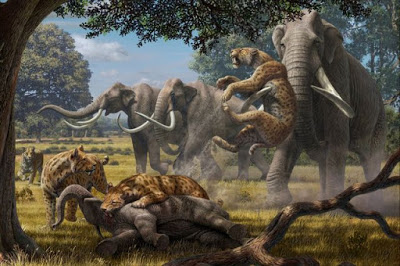
For years, evolutionary biologists have wondered how ecosystems during the Pleistocene epoch survived despite the presence of many species of huge, hungry herbivores, such as mammoths, mastodons and giant ground sloths. Observations on modern elephants suggest that large concentrations of those animals could have essentially destroyed the environment, but that wasn’t the case.
Now life scientists from UCLA and other universities in the U.S. and England argue that the ecosystem was effectively saved by predatory animals that helped keep the population of large herbivores in check. Their findings, reported this week in the journal Proceedings of the National Academy of Sciences, show that intense, violent attacks by packs of some of the world’s largest carnivores — including lions much larger than those of today and sabertooth cats — went a long way toward shaping ecosystems during the Pleistocene epoch.
The research could have implications for animal conservation efforts today. The paper notes that many of today’s endangered species evolved during or before the Pleistocene epoch, and under very different conditions from today’s.
“Recreating these [Pleistocene] communities is not possible, but their record of success compels us to maintain the diversity we have and rebuild it where feasible,” the researchers write.
Led by Blaire Van Valkenburgh, a UCLA evolutionary biologist, the researchers found that, because of their larger size, the ancient carnivores were very capable of killing young mammoths, mastodons and other species, which prevented those animals from destroying ecosystems in the Pleistocene, which ended about 11,700 years ago. The paper suggests that the extinction of the largest of the “hyper-carnivores” (such as lions, sabertooth cats and hyenas) during the late Pleistocene almost certainly was caused by the disappearance of their preferred prey, including young mega-herbivores (the mammoths, mastodons and giant ground sloths).
“Based on observations of living mega-herbivores, such as elephants, rhinos, giraffes and hippos, scientists have generally thought that these species were largely immune to predation, mainly because of their large size as adults and strong maternal protection of very young offspring,” said Van Valkenburgh, who holds an appointment in the UCLA College’s department of ecology and evolutionary biology.
“Data on modern lion kills of elephants indicates that larger prides are more successful and we argue that Pleistocene carnivore species probably formed larger prides and packs than are typically observed today — making it easier for them to attack and kill fairly large juveniles and young adult mega-herbivores.”
The scientists used several different techniques and data sources to estimate information about the Pleistocene animals. Among them:
- Examining fossils of their teeth and applying the ratio of tooth size to body mass of today’s animals. (This led the researchers to estimate that the extinct species were between 50 and 100 percent larger than today’s tigers, African lions and spotted hyenas.)
- Synthesizing data on the relationship between the age and shoulder height of the extinct animals versus shoulder height and body mass of today’s elephants.
- Analyzing data on 50,000 instances of kills in the wild to estimate the typical and maximum sizes of the prey of Pleistocene carnivores.
Many scientists had thought that the populations of mammoths, mastodons and giant ground sloths were limited through evolution by changes in reproductive timing in response to shortages in resources like food and water.
Today’s large predators benefit their ecosystems in part by providing carcasses that feed an array of smaller species. The same was true during the Pleistocene, when keeping mega-herbivore populations in check meant that there was more vegetation for smaller mammals and birds. The predators might even have had indirect effects on river ecosystems, because the banks of the rivers were not being denuded by mega-herbivores and less likely to erode.
The study’s co-authors are Matthew Hayward of Bangor University College of Natural Sciences in England, William Ripple of Oregon State University, Carlo Meloro of Liverpool John Moores University in England and V. Louise Roth of Duke University.
Reference:
Blaire Van Valkenburgh, Matthew W. Hayward, William J. Ripple, Carlo Meloro, and V. Louise Roth. The impact of large terrestrial carnivores on Pleistocene ecosystems. PNAS, October 26, 2015 DOI: 10.1073/pnas.1502554112
Note:The above post is reprinted from materials provided by University of California – Los Angeles. The original item was written by Stuart Wolpert.










